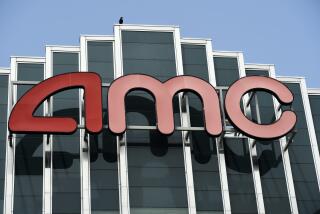AMC Theatre to open in Porter Ranch as cinema giant grows in L.A.

In January 1975, college freshman John McDonald got a job as an usher tearing tickets at the newly opened six-screen AMC multiplex in City of Industry. At the time, the theater wasn’t even getting first-run movies due to competing cinemas around Covina.
“I started off thinking it would be a fun job to go to school on,” McDonald recalled. “I remember one of the first movies I saw when I was at the theater was ‘Chinatown,’” which had premiered months earlier. “It’s still one of my favorite movies of all time.”
Forty-five years later, McDonald, 62, is head of U.S. operations at Leawood, Kan.-based AMC Theatres, now the world’s largest cinema operator and also owner of the biggest circuit in the U.S. More than half a century after AMC opened its first West Coast location in La Habra, the chain’s presence in the Los Angeles region has grown to 34 theaters and 461 screens, making it the company’s biggest market.
And the cinema giant’s footprint here is growing. AMC is set to soon open its long-planned nine-screen cinema in Porter Ranch, its first new L.A. theater in a decade. The 37,000-square-foot venue will feature recliner seating, immersive Dolby Cinema technology, and an extensive food and alcohol menu (company executives declined to say how much it cost to build). The multiplex located on Rinaldi Street will serve as the entertainment anchor for the Vineyards shopping district, which features a Whole Foods, a nail spa and several restaurants.
AMC’s Southern California expansion is expected to continue in the coming years. The company recently singed a deal to build a high-end 12-screen, 55,000-square-foot theater at Westfield Topanga, which will replace the company’s nearby Promenade 16 theater. Despite the high number of screens serving the L.A. market, McDonald said the company will keep looking for places where it can grow, like in the Inland Empire where the company is building a theater at the Montclair Place shopping and dining center. It will also continue to retrofit older theaters.
“We’ll continue to look for pockets of opportunity, like what we did in Porter Ranch or Montclair,” McDonald said. “But I think you’re just as likely to see us do things like what we did at Marina Del Rey, Fullerton or South Bay Galleria, where we remodel the theater. L.A. is a very important market for us, and we continue to view it as one of our cornerstone markets in the U.S.”
Los Angeles has long been a key locale for AMC because of its status as the home of the film business and an avid moviegoing populace. Two of AMC’s theaters, Burbank 16 and Century City 15, are among the company’s flagship locations.
The new Porter Ranch theater, scheduled to open next week, is intended to draw locals from the affluent San Fernando Valley neighborhood. The theater reflects a broader trend for new cinemas, which sacrifice size and seating capacity for comfort and upscale amenities. Over the last decade or so AMC and other chains have invested billions to upgrade their existing theaters with more luxurious seating, full kitchens and bars to combat long-term declines in movie theater attendance.
As populations like L.A.’s become denser and consumers demand more convenience, theater companies have focused on building theaters specifically for local communities. Mexican cinema operator Cinépolis in late 2018 revived the classic Bay Theatre in Pacific Palisades as a five-screen location with coastal-themed menu items, vegan options and an exclusive wine list. Austin, Texas-based Alamo Drafthouse in July opened its new location at the Bloc in downtown L.A., with 12 auditoriums and a lounge area that includes a video store offering free rentals.
“AMC, along with everyone else, has to be a little measured because of how many decent theaters there are there,” said Jim Amos, former studio distribution executive and founder of consultancy Scout 53. “There is a concentration around these localized movie theaters that people can call their own.”
The industry’s move toward smaller, cozier theaters represents a significant change from the mid-’90s, when AMC led a boom in megaplex theaters starting with its 24-screen behemoth in Dallas, followed by its 30-screen, 5,400-seat Ontario Mills colossus the following year.
“The industry in the last decade or so has kind of right-sized the number of screens and seats,” McDonald said. “Porter Ranch will have state-of-the-art amenities that we have in our newer-generation theaters. They tend to be very popular, but they’re much smaller.”
AMC’s first theater here, the AMC Fashion Square 4 in La Habra, opened in 1969, just a few years before McDonald joined the company. Early in his tenure, McDonald managed locations including Rosemead 4, Hawthorne Plaza 6 and Orange Mall 6, all of which have since closed. The original La Habra cinema shut down in 1992.
In the mid-1980s, AMC grew significantly by opening its multiplexes in Burbank and Century City. The latter was a gamble when it opened in 1987 because most moviegoing was concentrated in Westwood and Hollywood.
“When we first built Century City, we had a difficult time getting product,” McDonald said. “We eventually got Columbia to give us a title we were able to gross on, and it proved that Century City could gross just as well as Westwood.”
AMC’s last newly built theater in Los Angeles was Atlantic Times Square 14 in Monterey Park, which premiered in 2010. Since then, the company has stuck to retrofitting older theaters, like the Marina 6 in Marina Del Rey, which it opened as its first Los Angeles dine-in location eight years ago.
The company, owned by China’s Dalian Wanda Group, has faced steep challenges because of box-office headwinds and a significant debt load. Industry-wide ticket sales in the U.S. and Canada last year totaled $11.4 billion, down 4% from the previous year despite massive hits including “Avengers: Endgame” and “The Lion King.” AMC’s stock has dropped about 50% in the last 12 months to $7 a share. AMC in 2017 sold its 50% stake in Los Angeles-based studio Open Road Films, which later went bankrupt.
The company has made moves to buttress attendance. Spurred by the popularity of the now-defunct discount service MoviePass, AMC in 2018 debuted its subscription service Stubs A-List, allowing patrons to attend up to three movies a week for about $24 a month in California. AMC also recently launched a programming initiative called Artisan Films, meant to promote the non-blockbuster movies that tend to get drowned out by Hollywood’s big-budget franchises. The initiative has promoted movies including Autumn de Wilde’s “Emma,” Celine Sciamma’s “Portrait of a Lady on Fire” and Nat Faxon and Jim Rash’s “Downhill.”
AMC Entertainment revenue reached $1.32 billion in the third quarter of last year, up 8% from a year ago. The company posted a net loss of $54.8 million in the quarter, but the losses were much narrower than the same period in 2018.
On a November earnings call, AMC Chief Executive Adam Aron credited the Stubs A-list program with boosting sales.
“It’s not the only reason for the surge in our U.S. theater attendance, but it is certainly one of the major reasons,” he said.
More to Read
Inside the business of entertainment
The Wide Shot brings you news, analysis and insights on everything from streaming wars to production — and what it all means for the future.
You may occasionally receive promotional content from the Los Angeles Times.











